Abstract
A laser diode (LD) end-pumped continuous-wave (CW) tunable Nd3+:LiYF4 (Nd:YLF) laser operating on the 4F3/2→4I13/2 transition was performed. Four single-wavelength (SW) lasing at 1321, 1314, 1371, and 1364 nm in the π-polarized direction and three SW lasing at 1314, 1326, and 1371 nm in the σ-polarized direction were achieved using a tuning prism. At 20 W pump power, the σ-polarized 1314 nm emission generated 7.3 W power output with 39.4% slope efficiency. Further, the three-pair of switchable π-polarized dual-wavelengths (DWs) at 1321/1314 nm, 1371/1364 nm, and 1321/1364 nm and the two-pair of switchable σ-polarized DWs at 1314/1326 nm and 1314/1371 nm were also realized by rotating an intracavity birefringence filter (BF). In addition, by employing dual intracavity BFs, the balanced DW output power was attained, achieving 6.4 W total maximum output at 1314/1321 nm in the π-polarized direction.
1. Introduction
Continuous-wave (CW) lasers emitting in the 1.3–1.4 μm spectral range have gained significant attention due to their diverse applications, including medical laser technologies, environmental monitoring, fiber-optic telecommunications, and visible light generation through nonlinear optical processes [1,2,3,4,5]. Recent advancements in solid-state laser systems have demonstrated successful implementation of single-wavelength (SW) operation within this spectral band using various Nd-doped laser crystals. Notable achievements include development in Nd:YAG [6,7], Nd:Vanadates [7,8,9,10,11,12,13,14,15], Nd:YLF [16], and Nd:YAP [17], highlighting progress in this technologically important wavelength region. Dual-wavelength (DW) lasers with the orthogonal polarization demonstrate significant potential across multiple technological domains, particularly in advanced optical applications such as atmospheric sensing [18], biomedical device development [19], holographic imaging [20,21] and ultra-precise spectral analysis [22]. Their unique wavelength combination capability enables critical functions in self-referencing metrological systems [23], visible/UV light generation via sum-frequency generation and THz wave production via difference-frequency generation [24,25,26,27,28]. In parallel, DW lasers with the same polarization enhance precision metrology and lidar systems by minimizing phase noise and improving interference stability, crucial for atmospheric sensing and high-resolution distance measurements [29]. Additionally, identical polarization alignment in fiber-optic communication (such as wavelength division multiplexing) suppresses inter-channel crosstalk, enabling higher data transmission capacity [30]. Of particular scientific interest are DWs within the 1.3–1.4 μm spectral band [31,32,33,34,35], which show exceptional applicability in quantum precision instruments like silver atom optical clocks, atomic cooling systems operating beyond Doppler limitations, and advanced phototherapeutic implementations [36,37,38]. As a prominent active medium for solid-state laser systems, Nd:YLF crystals exhibit distinctive advantages including intrinsic birefringent properties, minimized thermal lensing effects, and extended radiative decay characteristics [39,40,41,42,43]. Figure 1 illustrates the wavelength-dependent emission cross-sections across the 1.3–1.4 μm spectral range, derived through calculation using the Füchtbauer–Ladenburg formalism [44]. In this study, we achieved the first tunable SW and DW lasers in Nd:YLF crystal in the 1.3–1.4 μm spectral region. Seven CW SWs are realized with the tuning prism. Further, the five-pair of CW DWs are obtained with an intracavity birefringence filter (BF). In addition, the balanced DW power output was also generated with the dual intracavity BFs.
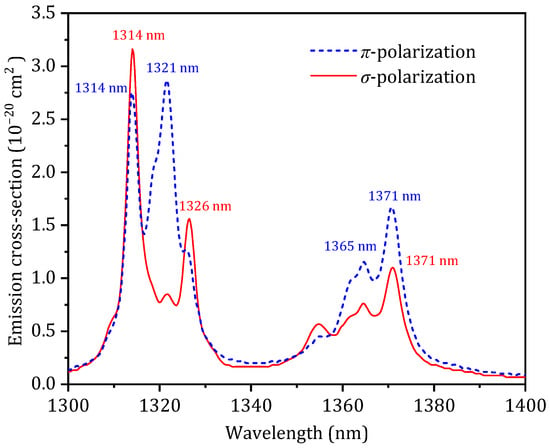
Figure 1.
Emission spectra of the Nd:YLF in the 1.3–1.4 μm spectral region.
2. Experimental Details
The schematic diagram of the tunable Nd:YLF laser operating on the 4F3/2→4I13/2 transition is displayed in Figure 2a. The pumping source was an LD, providing a central emission wavelength at 806 nm and a 20 W maximum power. The pump light was output by an optical fiber coupling with a 400 μm core diameter and a 0.22 numerical aperture. The spot radius of the pump light was 200 μm. Both identical convex lenses (L1 and L2) with a focal length of the 150 mm and anti-reflection (AR) film for the pump wavelength was used to collimate and focus the pump light into the active medium. A Nd:YLF cut along the a-axis (1.0 at.% doping, 5 mm length) functioned as the active medium with AR at 806 nm and 1310–1380 nm, which was sealed in indium foil and affixed to red copper mounts equipped with water cooling, maintained at 15 °C. The cavity input coupler was a planar mirror (M1) with high reflectivity (HR) for 1310–1380 nm and AR for 806 nm, 1040–1060 nm. The cavity output coupler was a concave mirror (M2) of −300 mm radius of curvature with a transmittance (Toc) of 3.5% at 1310–1380 nm. Two other couplers (Toc = 2.0% and Toc = 5.0%) were also carried out, with the M2 demonstrating the optimal output performance. To obtain SW tuning, a prism with AR for 1310–1380 nm and a plane reflector (M3) with HR for 1310–1380 nm were utilized. By adjusting the M3, SW tuning can be achieved. A polarization beam splitter (PBS) was used to separate two laser beams with orthogonal polarization. To realize DW tuning, a 1.0 mm-thick quartz BF1 was employed as a tuning element, as displayed in Figure 2b. To obtain the balanced DW power output, both BF1 and BF2 (0.5 mm thick) were utilized, as displayed in Figure 2c. To realize the π-polarized DW laser, the placement direction of BF1 is displayed in Figure 2d. The BF1 placed in this way can effectively suppress the σ-polarization because when the direction of the σ-polarized beam was perpendicular to the incident plane (S-wave), the reflection loss of the S-wave was the greatest when it was incident at the Brewster angle. Similarly, the placement direction of BF2 can suppress the π-polarized beam and achieve σ-polarized DW laser output.

Figure 2.
The schematic diagrams for SW (a), DW (b) and balanced power DW (c) tunable Nd:YLF laser. (d,e) are the BF1 and BF2 with orthogonal incident planes, respectively. θB is the Brewster angle, C is the crystal axis of the quartz BF1 and BF2.
3. Results and Discussion
The wavelength tuning was achieved by rotating the reflector M3, enabling discrete π-polarized lasing at 1321, 1314, 1371, and 1364 nm wavelengths, as detailed in Figure 3. Under 20 W pumping, the laser demonstrated output powers reaching 6.71 (1321 nm), 6.02 (1314 nm), 4.11 (1371 nm), and 1.80 (1364 nm) with corresponding lasing thresholds of 1.52, 1.61, 2.70, and 4.22 W, respectively. Their corresponding slope/optical efficiencies were 36.1/33.5% (1321 nm), 33.2/30.0% (1314 nm), 23.9/20.5% (1371 nm), and 11.6/9.0% (1364 nm), respectively. In a four-level laser system, the emission cross-section of the laser transition wavelength is a key influencing factor of the output power. The size of the emission cross-section of the transition wavelength in Figure 1 is consistent with the trend of the output power obtained experimentally. Using the LABRAM-UV spectrum analyzer (HORIBA France SAS, Paris, France) with a resolution of 0.01 nm to scan the laser wavelengths and deal with the data with software, the laser spectra of the π-polarized SW emissions at the maximum pumping, as displayed in Figure 4. The central wavelengths were 1321.2, 1314.0, 1370.6, and 1364.4 nm with the corresponding linewidths (FWHM) of 0.20, 0.16, 0.18, and 0.22 nm. Their corresponding beam quality factors (M2) were 1.11, 1.08, 1.20, and 1.14, respectively. The power stabilities of the SW lasers were measured with a precision power meter, demonstrating all <2.3% over a 1 h.
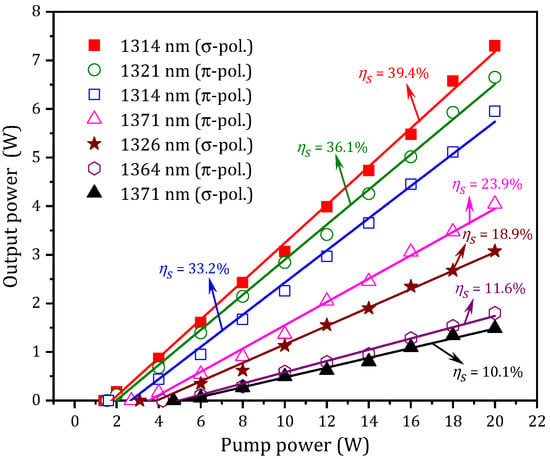
Figure 3.
Output power of the SWs versus the pump power of 806 nm.
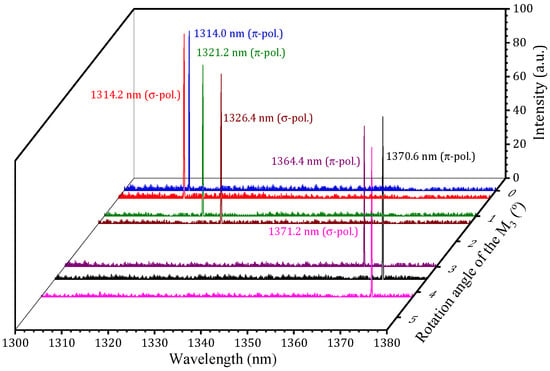
Figure 4.
Output spectra of the SWs for the Nd:YLF laser operating on the 4F3/2→4I13/2 transition.
Similarly, the three σ-polarized SWs (1314.2, 1326.4, and 1371.2 nm) were also generated, as detailed in Figure 3. Under 20 W pumping, the laser demonstrated output powers reaching 7.30 (1314 nm), 3.09 (1326.4 nm), and 1.51 W (1371.2 nm), with corresponding lasing thresholds measured at 1.40, 3.11, and 4.72 W, respectively. Their slope/optical conversion efficiencies reached 39.4/36.5% (1314.2 nm), 18.9/16.5% (1326.4 nm), and 10.1/7.5% (1371.2 nm), respectively. The laser spectra of the σ-polarized SW emissions at the maximum pumping are also displayed in Figure 4. The linewidths of 1314.2, 1326.4, and 1371.2 nm were 0.15 (M2 = 1.12), 0.19 (M2 = 1.19) and 0.23 nm (M2 = 1.23), respectively. The power stabilities of the three SW lasers were all <5% over 1 h.
The single-pass transmittance, TBF (λi), for different lasing wavelengths, λi, transmitted through the BF is expressed as [45]
where i represents different lasing wavelengths, γ is an angle between the incident ray and the BF crystal axis, α (tuning angle or rotation angle) is an angle between the crystal axis and the surface of the BF, θB is the Brewster angle, cosγ = cosθBcosα, δi = 2πd (no – ne)(1 – cos2αcos2θB)/λisinθB is an optical phase difference, ne and no are the refractive indices of e- and o-light, respectively, and d is the thickness of BF.
Using Equation (1) with the parameters: θB = 57.15o, ne = 1.5534, no = 1.5443, and d = 1 mm, the cavity round-trip (dual-pass) transmittance (T2BF1,i) versus tuning angle (α) of the BF1 are displayed in Figure 5. It could be observed in Figure 5 that T2BF,i can be controlled by adjusting the BF1. Thus, the lasing output can be tuned between the emission wavelengths. For a four-level laser system operating with CW, the oscillation threshold of each emission wavelength in a DW operation is given by [46]
where Toc is the cavity mirror transmittance, is the cavity dual-pass loss, L0i is the cavity dual-pass passive loss, hvp is the energy of a pump photon, lc is the length of the active medium, ηq,i is the quantum efficiency, τi is the radiation lifetime, σi is the emission cross-section, rp(r,z) is the distribution the pump beam for the normalized intensity in the Nd:YLF, and si(r,z) is the cavity mode distribution of the normalized intensity for the emission wavelength. rp(r,z) and si(r,z) can be expressed as follows [47], respectively,
and
where α (=5.0 cm−1) is the absorption coefficient, r and z are radial and lateral coordinates, respectively, ωi is the laser spot radius, Θ is the Heaviside step function, and pump beam size in the Nd:YLF crystal is given by
where ωp0 is the pump spot radius, ωi is the laser spot radius, λp is the pump wavelength, (=45) is the quality factor of pump beam, and z0 is focal plane of the pump beam in the active medium. According to Equations (2)–(5), the π-polarized laser threshold power (Pth,i) versus the tuning angle are displayed in Figure 6. It could be observed that the laser threshold power can be controlled by adjusting the BF1. It could also be shown that there were crosspoints between any two of the three curves. When the pump power was controlled at a certain intersection point, DW laser could be generated simultaneously.

Figure 5.
Round-trip (dual-pass) transmittance versus tuning angle of BF1.
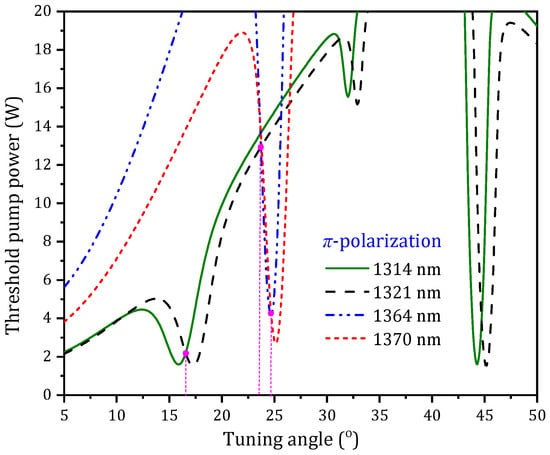
Figure 6.
π-polarized threshold power of the DW laser versus the tuning angle of the BF1.
By controlling the tuning angle α, the three-pair of the π-polarized DW lasers at 1321/1314, 1371/1364, and 1364/1321 nm were attained, respectively. The DW laser was separated into the same polarized beams with a flexible wavelength selector Mono F-14 (Spectrolight Inc., Irvine, CA, USA), and the output power for individual wavelengths were measured respectively. The DW laser output–input powers are displayed in Figure 7. At 20 W pump power, the total CW output power of 7.01 (3.71/3.30 W at 1321/1314 nm), 3.12 (1.71/1.41 W at 1371/1364 nm), and 0.78 W (0.45/0.33 W at 1321/1364 nm) were attained, respectively. Their total corresponding optical conversion efficiencies reached 35.1, 16.5, and 3.9%, respectively. The π-polarized DW spectra at the maximum pumping are displayed in Figure 8. The central wavelengths were 1321.3/1314.1 nm, 1370.6/1364.4 nm, and 1321.2/1364.1 nm, with the spectral line widths of 0.23/0.17 nm, 0.14/0.17 nm, and 0.20/0.21 nm, respectively. The M2 factors of the three-pair of DWs were all <1.26. The power stabilities of the three-pair of DWs were all <4.0%.
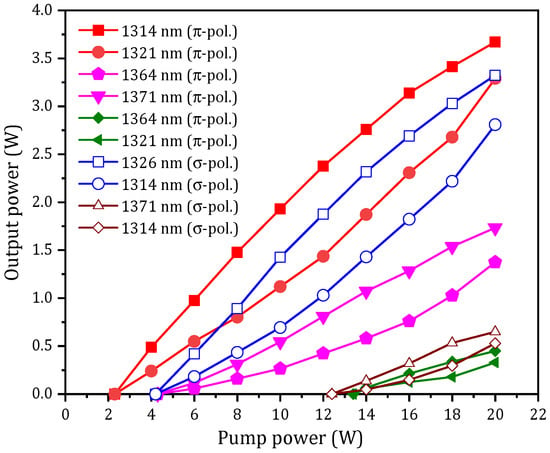
Figure 7.
DW output power in the two polarized directions versus the pump power.

Figure 8.
Output spectra of the DWs for the Nd:YLF laser operating on the 4F3/2→4I13/2 transition.
Similarly, the σ-polarized threshold power of the DW laser versus the tuning angle is displayed in Figure 9. The two-pair of σ-polarized DWs of 1326/1314 and 1371/1314 nm were realized. The power characteristics are displayed in Figure 7. The maximum total outputs of 6.10 (3.31/2.79 W at 1326/1314 nm) and 1.18 W (0.65/0.53 W at 1371/1314 nm) were attained, respectively. Their total corresponding optical efficiencies were 30.5, 16.5, and 5.9%, respectively. The σ-polarized DW spectra are also displayed in Figure 8. The central wavelengths were 1326.3/1314.2 nm and 1371.3/1314.2 nm, with spectral line widths of 0.15/0.17 nm and 0.17/0.20 nm, respectively. The M2 factors of the two-pair of DWs were all <1.36. The power stabilities of the two-pair of DWs were all <4.5%.
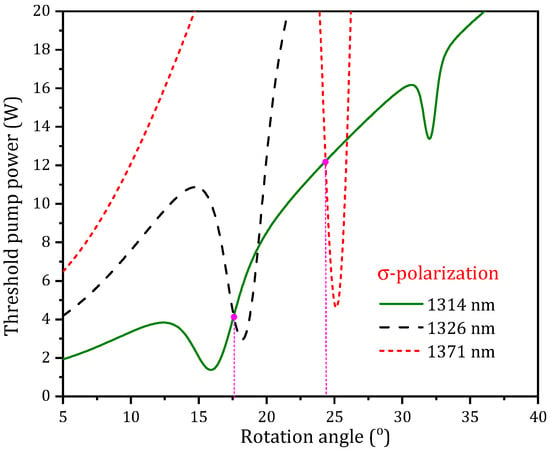
Figure 9.
σ-polarized threshold power of the DW laser versus the tuning angle of the BF1.
The slope efficiency of the input–output power for a four-level laser system can be given by [47]
Take the σ-polarized DW at 1326/1314 nm as an instance to demonstrate the achievement of a balanced output of the DW power. It can be obtained in Equation (2) that the equal threshold power for 1326 nm and 1314 nm DW operation requires L1326 < L1314. From Equation (3), it can be seen that ηs,1326 > ηs,1314 when L1326 < L1314 and L0,1326 ≈ L0,1314. A simple schematic is displayed in Figure 10a. This suggests that the two power outputs of the DW cannot be balanced. Hence, if the two output powers of the DW are to be balanced, a new intracavity loss must be introduced to break the DW equal threshold. A BF2 was put in the resonator, the dual-pass transmittance (T2BF2,i) of 1326 nm and 1314 nm was calculated as a function of tuning angle (β), as displayed in Figure 10. When the tuning angle of the BF1 was at α = 18o and the BF2 was adjusted between 0–12o, ηs,1326 > ηs,1314 was still maintained to be calculated by Equation (6), but Pth,1326 < Pth,1314, as displayed in Figure 10b. This suggests that their slope efficiencies always had an intersection point, that was, equal power values could be found.
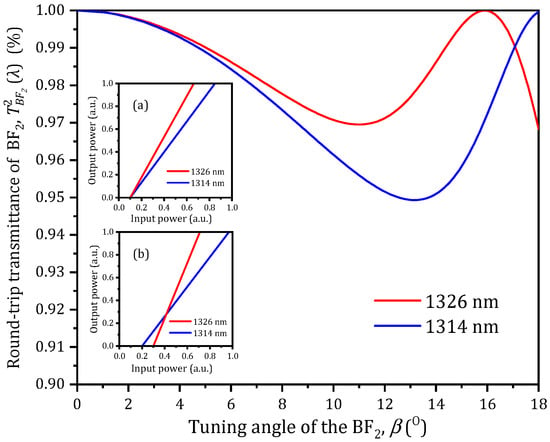
Figure 10.
Dual-pass transmittance versus tuning angle of BF2. (a) Slope efficiencies of 1326 and 1314 nm at Pth,1326 = Pth,1314. (b) Slope efficiencies of 1326 and 1314 nm at Pth,1326 > Pth,1314.
A balanced DW power at 1326/1314 nm in the σ-polarized direction was achieved with a total power output of 5.21 W at the maximum pumping by adjusting the BF2. The output–input characteristic of the DW is displayed in Figure 11. The corresponding total slope/optical efficiency was 33.6/26.1%. The M2 factor of the DW laser was <1.15. The power stability of the DW was <2.2% in 1 h. When the tuning angle of the BF1 was at α = 24° and the BF2 was adjusted, a balanced DW at 1314/1370 nm in the σ-direction was also achieved with a total power of 1.01 W, as also displayed in Figure 11. The corresponding total slope/optical efficiency was 13.2/5.1%. The M2 factor of the DW laser was <1.20. The power stability of the DW was <3.6% in 1 h. The direction of the BF1 and BF2 was adjusted so that the direction of the incident plane of the light was rotated by 90 degrees, as displayed in Figure 2e. The three-pair of the balanced DW at 1314/1321, 1364/1371, and 1321/1364 nm were also generated, respectively. The output–input characteristics of the DWs are also displayed in Figure 11. The total power was 6.42 (1321/1314 nm), 2.61 (1371/1364 nm), and 0.62 W (1364/1321 nm), respectively. The M2 factors of the DW lasers were <1.32. The power stabilities of the DW lasers were all <4.0% in 1 h.

Figure 11.
Total DW output power versus the pump power.
4. Conclusions
A LD-pumped CW tunable Nd:YLF laser operating on the 4F3/2→4I13/2 transition was demonstrated. Four π-polarized SW lasing at 1321, 1314, 1371, and 1364 nm and three σ-polarized SW lasing at 1314, 1326, and 1371 nm were achieved using a tuning prism. At 20 W pump power, the σ-polarized 1314 nm emission generated 7.3 W maximum power output with 39.4% slope efficiency. Further, the three-pair of switchable π-polarized DWs at 1321/1314 nm, 1371/1364 nm, and 1321/1364 nm and the two-pair of switchable σ-polarized DWs at 1314/1326 nm and 1314/1371 nm were also realized by rotating an intracavity BF. In addition, by employing dual intracavity BFs, the balanced DW output power was attained, achieving 6.4 W total maximum output at 1314/1321 nm in the π-polarized direction. We believe that the method presented in this paper has the potential to be extended to other laser crystals for obtaining tunable SW and DW lasers.
Author Contributions
Writing—original draft, C.C.; writing—review and editing, X.F.; investigation, S.W.; writing—review and editing, project administration, Z.D. All authors have read and agreed to the published version of the manuscript.
Funding
This work was supported by the Natural Science Training Project of Bohai University (0524xn04801, 0523bs05003).
Institutional Review Board Statement
Not applicable.
Informed Consent Statement
Informed consent was obtained from all subjects involved in this study.
Data Availability Statement
Data is contained within the article.
Conflicts of Interest
The authors declare no conflicts of interest.
References
- Jaque, D.; Capmany, J.; Solé, J. Red, green, and, blue laser light from a single Nd:YAl3(BO3)4 crystal based on laser oscillation at 1.3 μm. Appl. Phys. Lett. 1999, 75, 325–327. [Google Scholar] [CrossRef]
- Chen, Y.; Liu, K.; He, L.; Yang, J.; Zong, N.; Yang, F.; Gao, H.; Liu, Z.; Yuan, L.; Lan, Y. 10 kHz ps 1342 nm laser generation by an electro-optically cavity-dumped modelocked Nd:YVO4 laser. Opt. Laser Technol. 2017, 87, 26–30. [Google Scholar] [CrossRef]
- Xu, B.; Wang, Y.; Lin, Z.; Peng, J.; Cheng, Y.; Luo, Z.; Xu, H.; Cai, Z.; Weng, J.; Moncorge, R. Single- and multi-wavelength Nd:YALO3 lasers at 1328, 1339 and 1364 nm. Opt. Laser Technol. 2016, 81, 1–6. [Google Scholar] [CrossRef]
- Cong, H.; Xue, C.; Zheng, J.; Yang, F.; Yu, K.; Liu, Z.; Zhang, X.; Cheng, B.; Wang, Q. Silicon based GeSn p-i-n photodetector for SWIR detection. IEEE Photonics J. 2016, 8, 6804706. [Google Scholar] [CrossRef]
- Zhang, G.; Shen, H.; Zeng, R.; Huang, C.; Lin, W.; Huang, J. The study of 1341.4 nm Nd:YAlO3 laser intracavity frequency-doubling by LiB3O5. Opt. Commun. 2000, 183, 461–466. [Google Scholar] [CrossRef]
- Yue, S.; Cao, S.; Qin, W.; Jiang, M.; Liu, Y.; Cao, Y.; Wang, Z. Generation of 1319 nm Pulsed Vortex Laser by Annular Pumped Bonded Nd:YAG/V:YAG Crystal. Photonics 2025, 12, 303. [Google Scholar] [CrossRef]
- Ma, F.; Wang, S.; Li, B.; Shang, P.; Li, J.; Li, Z. Effect of Lower-Level Relaxation on the Pulse Generation Performance of Q-Switched Nd:YAG Laser. Photonics 2025, 12, 408. [Google Scholar] [CrossRef]
- Lenhardt, F.; Nittmann, M.; Bauer, T.; Bartschke, J.; Lhuillier, J. High-power 888-nm-pumped Nd:YVO4 1342-nm oscillator operating in the TEM00 mode. Appl. Phys. B 2009, 96, 803. [Google Scholar] [CrossRef]
- Li, F.; Liu, K.; Han, L.; Zong, N.; Bo, Y.; Zhang, J.; Peng, Q.; Cui, D.; Xu, Z. High-power 880-nm diode-directly-pumped passively mode-locked Nd:YVO4 laser at 1342 nm with a semiconductor saturable absorber mirror. Opt. Lett. 2011, 36, 1485–1487. [Google Scholar] [CrossRef]
- Jessica, D.; Luciana, R.; Wetter, N. Nd:YVO4 Random Laser with Preferential Emission at 1340 nm over 1064 nm. Photonics 2024, 11, 898. [Google Scholar] [CrossRef]
- Ogilvy, H.; Withford, M.; Dekker, P.; Piper, J. Efficient diode double-end-pumped Nd:YVO4 laser operating at 1342 nm. Opt. Express 2003, 11, 2411–2415. [Google Scholar] [CrossRef] [PubMed]
- Lü, Y.; Xia, J.; Wang, J.; Sun, G.; Zhang, X.; Zhang, A.; Yin, X.; Bao, L.; Quan, H. High-efficiency Nd:GdVO4 laser at 1341nm under 880nm diode laser pumping into the emitting level. Opt. Commun. 2009, 282, 3565–3567. [Google Scholar] [CrossRef]
- Du, C.; Qin, L.; Meng, X.; Xu, G.; Wang, Z.; Xu, X.; Zhu, L.; Xu, B.; Shao, Z. High-power Nd:GdVO4 laser at 1.34 μm end-pumped by laser-diode-array. Opt. Commun. 2002, 212, 177–181. [Google Scholar] [CrossRef]
- Zhang, H.; Liu, J.; Wang, J.; Xu, X.; Jiang, M. Continuous-wave laser performance of Nd:LuVO4 crystal operating at 1.34 µm. Appl. Opt. 2005, 44, 7439–7441. [Google Scholar] [CrossRef]
- Liu, F.; He, J.; Zhang, B.; Xu, J.; Dong, X.; Yang, K.; Xia, H.; Zhang, H. Diode-pumped passively Q-switched Nd:LuVO4 laser at 1.34 μm with a V3+:YAG saturable absorber. Opt. Express 2008, 16, 11759–11763. [Google Scholar] [CrossRef]
- Prado, F.; Franco, T.; Wetter, N. Efficient Trichromatic Nd:YLF Laser Emitting at 1047 nm, 1053 nm and 1314 nm. Photonics 2023, 10, 1146. [Google Scholar] [CrossRef]
- Zhu, H.; Huang, C.; Zhang, G.; Wei, Y.; Huang, L.; Chen, J.; Chen, W.; Chen, Z. High-power CW diode-side-pumped 1341 nm Nd:YAP laser. Opt. Commun. 2007, 270, 296–300. [Google Scholar] [CrossRef]
- Farley, R.; Dao, P. Development of an intracavity-summed multiple-wavelength Nd:YAG laser for a rugged, solid-state sodium lidar system. Appl. Opt. 1995, 34, 4269–4273. [Google Scholar] [CrossRef]
- Son, S.; Song, J.; Kang, J.; Kim, C. Simultaneous second harmonic generation of multiple wavelength laser outputs for medical sensing. Sensors 2011, 11, 6125–6130. [Google Scholar] [CrossRef]
- Weigl, F. A generalized technique of two-wavelength, nondiffuse holographic interferometry. Appl. Opt. 1971, 10, 187–192. [Google Scholar] [CrossRef]
- Abdelsalam, D.; Magnusson, R.; Kim, D. Single-shot, dual-wavelength digital holography based on polarizing separation. Appl. Opt. 2011, 50, 3360–3368. [Google Scholar] [CrossRef] [PubMed]
- Basov, N.; Gubin, M.; Nikitin, V.; Nikuchin, A.; Petrovskii, V.; Protsenko, E.; Tyurikov, D. Highly-sensitive method of narrow spectral-line separations, based on the detection of frequency resonances of a 2-mode gas-laser with non-linear absorption. Izv. Akad. Nauk. SSR Seriya Fiz. 1982, 46, 1573–1583. [Google Scholar]
- Zhang, S.; Tan, Y.; Li, Y. Orthogonally polarized dual frequency lasers and applications in self-sensing metrology. Meas. Sci. Technol. 2010, 21, 054016. [Google Scholar] [CrossRef]
- Huang, H.; Xia, J.; Anh, N.; Li, Y.; Zhang, Y.; Zhang, Q.; Zhao, Z.; Lü, Y. Orthogonally Polarized Dual-Wavelength Pr:LLF Green Laser at 546 nm and 550 nmwith the Balanced Output Powers at All Pump Power Level. Photonics 2025, 12, 393. [Google Scholar] [CrossRef]
- Huang, H.; Xia, J.; Anh, N.; Li, Y.; Lü, Y. Dual-Wavelength Operation at 607 nm and 640 nm with the Same Threshold and Slope Efficiency in Pr3+:LiLuF4 Crystal. Photonics 2025, 12, 447. [Google Scholar] [CrossRef]
- Du, Z.; Hu, Z.; Li, Y.; Anh, N.; Fu, X.; Li, B.; Bai, J. Tunable Yb:GdCOB self-frequency-doubling cyan laser. Laser Phys. Lett. 2024, 21, 025001. [Google Scholar] [CrossRef]
- Zhao, P.; Ragam, S.; Ding, Y.; Zotova, I. Power scalability and frequency agility of compact terahertz source based on frequency mixing from solid-state lasers. Appl. Phys. Lett. 2011, 98, 131106. [Google Scholar] [CrossRef]
- Huang, H.; Li, Y.; Lü, Y.; Anh, N.; Zhang, Q.; Xia, J. Orthogonally Polarized Green Dual-Wavelength Pr3+:LiLuF4 Laser at 523 and 538 nm with the Power Ratio of 1:1. Photonics 2025, 12, 591. [Google Scholar] [CrossRef]
- Junttila, S.; Vastaranta, M.; Liang, X.; Kaartinen, H.; Kukko, A.; Kaasalainen, S.; Holopainen, M.; Hyyppä, H.; Hyyppä, J. Measuring Leaf Water Content with Dual-Wavelength Intensity Data from Terrestrial Laser Scanners. Remote Sens. 2017, 9, 8. [Google Scholar] [CrossRef]
- Najm, M.; Nizamani, B.; Al-Azzawi, A.; Hmood, J.; Abdullah, M.; Harun, S. Generation of dual-wavelength Q-switched laser pulses by employing Mo2Ti2AlC3 MAX phase film. Opt. Fiber Technol. 2023, 81, 103566. [Google Scholar] [CrossRef]
- Chen, M.; Wang, Z.; Zhang, S.; Yang, F.; Zhang, F.; Yuan, L.; He, M.; Li, J.; Zhang, X.; Zong, N.; et al. 1319 nm and 1356 nm dual-wavelength operation of diode-side-pumped Nd:YAG laser. Opt. Laser Technol. 2016, 79, 52–54. [Google Scholar] [CrossRef]
- Guo, L.; Lan, R.; Liu, H.; Yu, H.; Zhang, H.; Wang, J.; Hu, D.; Zhuang, S.; Chen, L.; Zhao, Y.; et al. 1319 nm and 1338 nm dual-wavelength operation of LD end-pumped Nd:YAG ceramic laser. Opt. Express 2010, 18, 9098–9106. [Google Scholar] [CrossRef]
- Lü, Y.; Xia, J.; Zhang, J.; Fu, X.; Liu, H. Orthogonally polarized dual-wavelength Nd:YAlO3 laser at 1341 and 1339 nm and sum-frequency mixing for an emission at 670 nm. Appl. Opt. 2014, 53, 5141–5146. [Google Scholar] [CrossRef]
- Tu, Z.; Dai, S.; Zhu, S.; Yin, H.; Li, Z.; Ji, E.; Chen, Z. Efficient high-power orthogonally-polarized dual-wavelength Nd:YLF laser at 1314 and 1321 nm. Opt. Express 2019, 27, 32949–32957. [Google Scholar] [CrossRef]
- Li, S.; Li, T.; Zhao, S.; Li, G.; Hang, Y.; Zhang, P. 1.31 and 1.32 μm dual-wavelength Nd:LuLiF4 laser. Opt. Laser Technol. 2016, 81, 14–17. [Google Scholar] [CrossRef]
- Badr, T.; Plimmer, M.; Juncar, P.; Himbert, M. Observation by two-photon laser spectroscopy of the 4d105s2S1/2→4d95s22D5/2 clock transition in atomic silver. Phys. Rev. A 2006, 74, 062509. [Google Scholar] [CrossRef]
- Orringer, J.; Kang, S.; Maier, L.; Johnson, T.; Sachs, D.; Karimipour, D.; Helfrich, Y.; Hamilton, T.; Voorhees, J. A randomized, controlled, split-face clinical trial of 1320-nm Nd:YAG laser therapy in the treatment of acne vulgaris. J. Am. Acad. Dermatol. 2007, 56, 432–438. [Google Scholar] [CrossRef] [PubMed]
- Louyer, Y.; Balembois, F.; Plimmer, M.; Badr, T.; Georges, P.; Juncar, P.; Himbert, M. Efficient cw operation of diode-pumped Nd:YLF lasers at 1312.0 and 1322.6 nm for a silver atom optical clock. Opt. Commun. 2003, 217, 357–362. [Google Scholar] [CrossRef]
- Pollak, T.; Wing, W.; Grasso, R.; Chicklis, E.; Jenssen, H. CW Laser Operation of Nd:YLF. IEEE J. Quantum Electron. 1982, 18, 159–163. [Google Scholar] [CrossRef]
- Xu, S.; Gao, S. A new wavelength laser at 1370 nm generated by Nd:YLF crystal. Mater. Lett. 2016, 183, 451–453. [Google Scholar] [CrossRef]
- Shang, P.; Bai, L.; Wang, S.; Cai, D.; Li, B. Research progress on thermal effect of LD pumped solid state laser. Opt. Laser Technol. 2023, 157, 108640. [Google Scholar] [CrossRef]
- Chuang, T.; Verdún, H. Energy Transfer Up-Conversion and Excited State Absorption of Laser Radiation in Nd:YLF Laser Crystals. IEEE J. Quantum Electron. 1996, 32, 79–91. [Google Scholar] [CrossRef]
- Zhang, Z.; Liu, Q.; Nie, M.; Ji, E.; Gong, M. Experimental and theoretical study of the weak and asymmetrical thermal lens effect of Nd:YLF crystal for π- and σ-polarizations. Appl. Phys. 2015, 120, 689–696. [Google Scholar] [CrossRef]
- Huber, G.; Krühler, W.; Bludau, W.; Danielmeyer, H. Anisotropy in the laser performance of NdP5O14. J. Appl. Phys. 1975, 46, 3580–3584. [Google Scholar] [CrossRef]
- Wang, X.; Yao, J. Transmitted and tuning characteristics of birefringent filters. Appl. Opt. 1992, 31, 4505–4508. [Google Scholar] [CrossRef]
- Fan, T.; Byer, R. Diode laser-pumped solid-state lasers. IEEE J. Quantum Electron. 1988, 24, 895. [Google Scholar] [CrossRef]
- Chen, Y. cw dual-wavelength operation of a diode-pumped Nd:YVO4 laser. Appl. Phys. B 2000, 70, 475–478. [Google Scholar] [CrossRef]
Disclaimer/Publisher’s Note: The statements, opinions and data contained in all publications are solely those of the individual author(s) and contributor(s) and not of MDPI and/or the editor(s). MDPI and/or the editor(s) disclaim responsibility for any injury to people or property resulting from any ideas, methods, instructions or products referred to in the content. |
© 2025 by the authors. Licensee MDPI, Basel, Switzerland. This article is an open access article distributed under the terms and conditions of the Creative Commons Attribution (CC BY) license (https://creativecommons.org/licenses/by/4.0/).